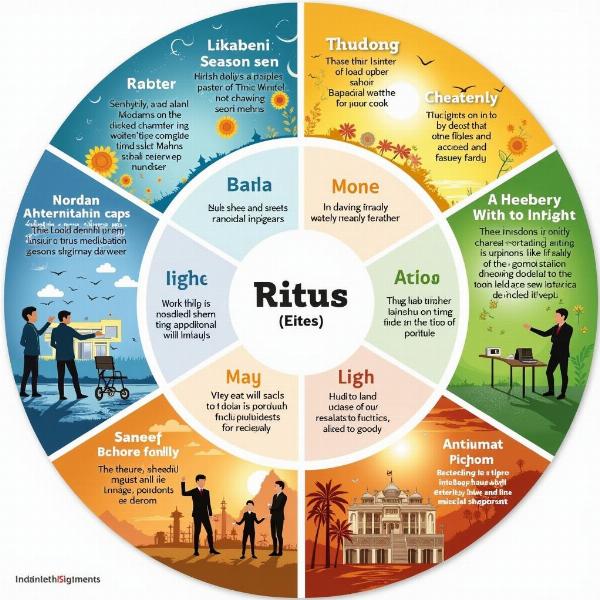Understanding the names of seasons in both English and Hindi is essential for anyone interested in Indian culture, language, or even just planning a trip. This guide provides a complete overview of seasons name in English and Hindi, delving into their cultural significance and practical implications.
Seasonal Variations Across India
India’s diverse climate means that seasonal experiences vary significantly across the country. While some regions experience distinct four seasons, others primarily witness a wet and dry period. This variation enriches India’s cultural tapestry and is reflected in the nuanced vocabulary used to describe the seasons.
The Six Main Seasons in the Indian Calendar
Traditionally, the Indian calendar recognizes six main seasons (Ritus), each with its own distinct characteristics and cultural associations. These seasons are deeply rooted in ancient Indian texts and continue to influence agricultural practices, festivals, and everyday life.
Spring (Vasant Ritu – वसंत ऋतु)
Spring, known as Vasant Ritu in Hindi, is a time of renewal and vibrant colours. The weather is pleasant, flowers bloom, and festivals like Holi are celebrated with great enthusiasm.
Summer (Grishma Ritu – ग्रीष्म ऋतु)
Summer, or Grishma Ritu, is characterized by intense heat. People seek relief in cool drinks and lighter clothing. Mangoes, a beloved summer fruit, are enjoyed during this time.
Monsoon (Varsha Ritu – वर्षा ऋतु)
Varsha Ritu, the monsoon season, brings much-needed rain after the scorching summer. It’s a time of rejuvenation for nature and a welcome respite from the heat.
Autumn (Sharad Ritu – शरद ऋतु)
Sharad Ritu, or Autumn, is marked by clear skies and pleasant temperatures. It’s a time for harvest festivals and celebrations like Diwali.
Pre-winter (Hemant Ritu – हेमंत ऋतु)
Hemant Ritu is the pre-winter season, bridging autumn and winter. The weather becomes cooler, and preparations for the colder months begin.
 Six Seasons of Indian Calendar
Six Seasons of Indian Calendar
Winter (Shishir Ritu – शिशिर ऋतु)
Winter, known as Shishir Ritu, is the coldest season. People wear warm clothes and enjoy bonfire nights.
Seasons Name in English and Hindi: A Quick Reference
Here’s a table summarizing the seasons name in English and Hindi:
| English Name | Hindi Name (Devanagari) | Hindi Name (Romanized) |
|---|---|---|
| Spring | वसंत ऋतु | Vasant Ritu |
| Summer | ग्रीष्म ऋतु | Grishma Ritu |
| Monsoon | वर्षा ऋतु | Varsha Ritu |
| Autumn | शरद ऋतु | Sharad Ritu |
| Pre-winter | हेमंत ऋतु | Hemant Ritu |
| Winter | शिशिर ऋतु | Shishir Ritu |
The Four Seasons and Their Cultural Significance
While the six Ritus are deeply embedded in Indian culture, the four-season classification (spring, summer, autumn, and winter) is also commonly used, especially in educational contexts and everyday conversations. These four seasons are frequently depicted in Indian literature, art, and music, reflecting their importance in the cultural landscape.
Conclusion
Understanding seasons name in English and Hindi allows for a deeper appreciation of India’s rich cultural heritage and its connection to the natural world. This guide provides a comprehensive resource for anyone seeking to learn more about this fascinating aspect of Indian culture. Remember that while the four-season model is commonly understood, exploring the traditional six Ritus provides a much richer understanding of the Indian perspective on the cycle of nature.
FAQ
- How many seasons are there in India? Traditionally, there are six seasons (Ritus) in the Indian calendar.
- What is the hottest season in India? Grishma Ritu (Summer) is the hottest season in India.
- When does the monsoon season start in India? The monsoon season generally starts in June and lasts until September.
- Which season is Diwali celebrated in? Diwali is celebrated in Sharad Ritu (Autumn).
- What is Hemant Ritu? Hemant Ritu is the pre-winter season, between autumn and winter.
- What is the Hindi word for spring? The Hindi word for spring is Vasant Ritu (वसंत ऋतु).
- What are the names of the six seasons in Hindi? Vasant (spring), Grishma (summer), Varsha (monsoon), Sharad (autumn), Hemant (pre-winter), and Shishir (winter).
Meaning-Hindi.in offers professional translation services between Hindi and various other languages, specializing in business, legal, technical, website, educational, and specialized translations. We ensure accurate, culturally sensitive, and timely delivery of your translation projects. Need help with translating documents related to seasons, festivals, or any other cultural topics? Contact us at [email protected] or call us at +91 11-4502-7584. Meaning-Hindi.in is your trusted partner for all your Hindi translation needs.